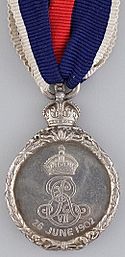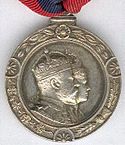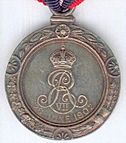King Edward VII Coronation Medal facts for kids
Quick facts for kids King Edward VII Coronation Medal |
|
|---|---|
|
King Edward VII Coronation Medal in silver Medal awarded to Mayors and Provosts
|
|
| Presented by | United Kingdom |
The King Edward VII Coronation Medal was a special medal made in 1902. It was created to celebrate the coronation of King Edward VII and Queen Alexandra. A coronation is a ceremony where a king or queen is officially crowned.
Contents
Who Received the Medal?
This medal was given out in two types: silver and bronze. Important people like members of the royal family, government leaders, and high-ranking military officers received the silver medal. They got it if they were at the coronation ceremony, helped prepare for it, or took part in the coronation parade.
Bronze Medals for Service
Some soldiers and sailors also received the bronze medal. This included non-commissioned officers (NCOs) and other ranks who were part of the coronation parade. An NCO is a military leader who is not an officer, like a sergeant.
The bronze medal was also given to one sailor or marine from each ship at the Spithead Naval Review. This was a big event where many navy ships gathered. It happened on August 16, 1902.
Interestingly, two nurses from the Queen Alexandra's Imperial Military Nursing Service also received bronze medals. They had cared for King Edward VII when he was sick before his coronation.
How the Medal Was Worn
People wore the medal on the left side of their chest. It hung from a colorful ribbon. Until November 1918, these special commemorative medals were worn before medals given for military campaigns. After that, the order changed, and they were worn after campaign medals. Ladies could wear their medal near their left shoulder, with the ribbon tied in a bow.
What the Medal Looks Like
The King Edward VII Coronation Medal was designed by an artist named Emil Fuchs.
- It is shaped like an oval and is about 30 by 38 millimeters in size.
- A small crown sits on top of the medal.
- On the front, called the obverse, you can see the faces of King Edward VII and Queen Alexandra. They are crowned and looking to the left. A wreath, which is a circle of leaves, goes around their faces.
- The back of the medal, called the reverse, shows the King's special symbol (his cypher) above the date "26 June 1902." It also has a wreath around it, just like the front.
- These medals were given out without any names engraved on them.
A Delayed Coronation
The coronation was originally planned for June 26, 1902. However, King Edward VII became ill with appendicitis and needed surgery. Because of this, the coronation had to be postponed. It finally took place on August 9, 1902. The medals had already been made with the earlier date, so they still show "26 June 1902."
Different Kinds of Coronation Medals
There were a few different versions of the coronation medal.
- The main medal, given to royalty, officials, and the armed forces, has a dark blue ribbon. This ribbon has a red stripe in the middle and white edges on both sides.
- There was a special silver medal just for mayors and provosts. Mayors and provosts are leaders of towns or cities. This medal was round, but its design was similar to the oval one. Its ribbon was dark blue with red edges and a thin white stripe in the middle.
- The Police Coronation Medal was a different, larger round medal. It was given to police officers in both silver and bronze. Its ribbon was red with a thin blue stripe in the middle.





